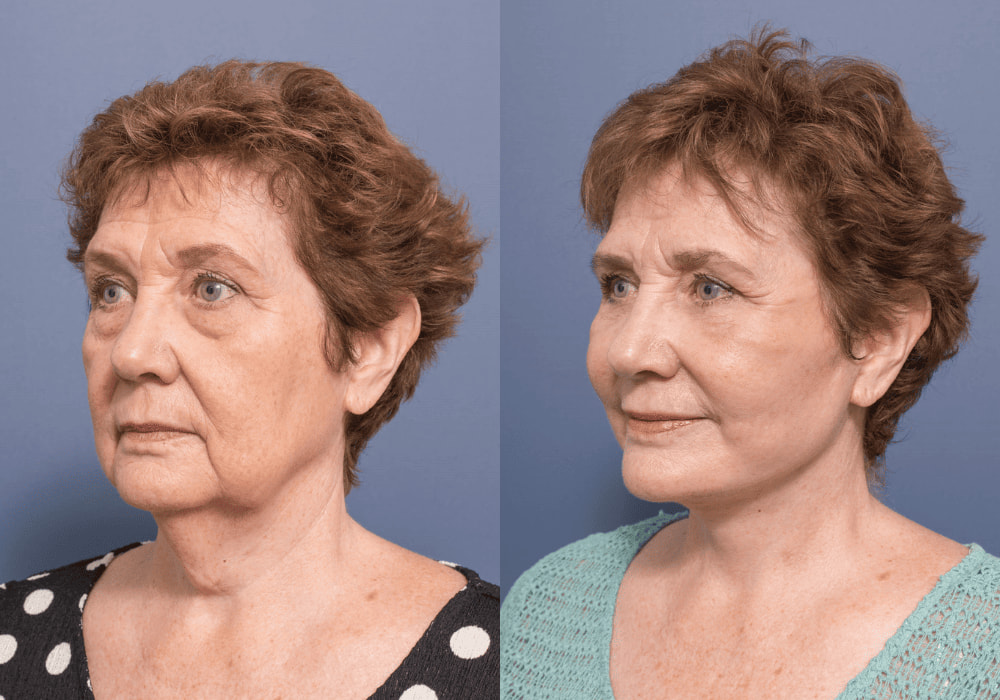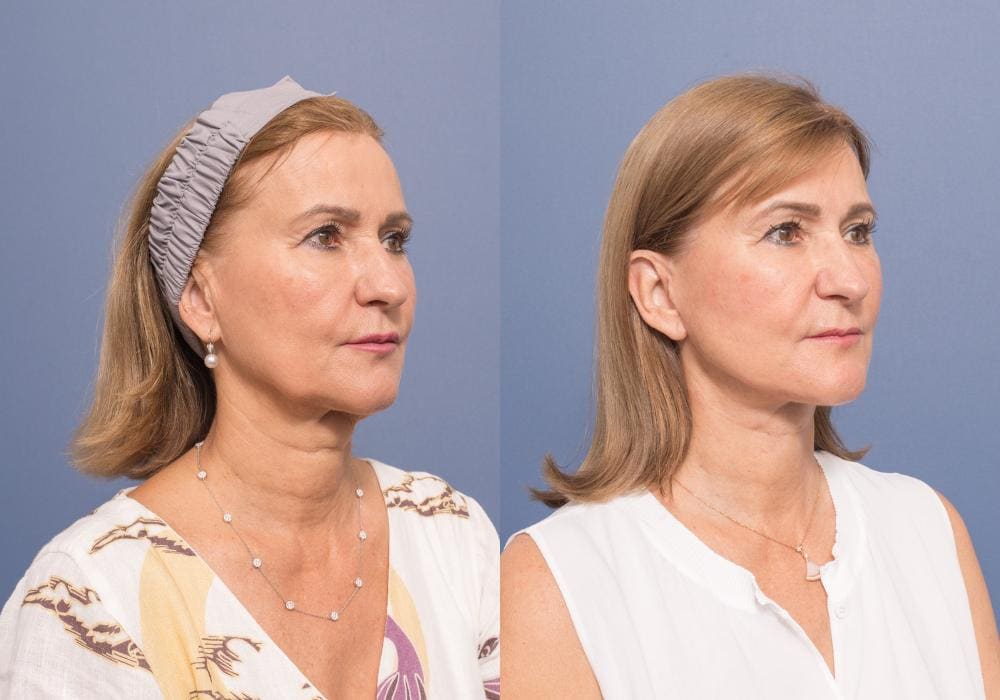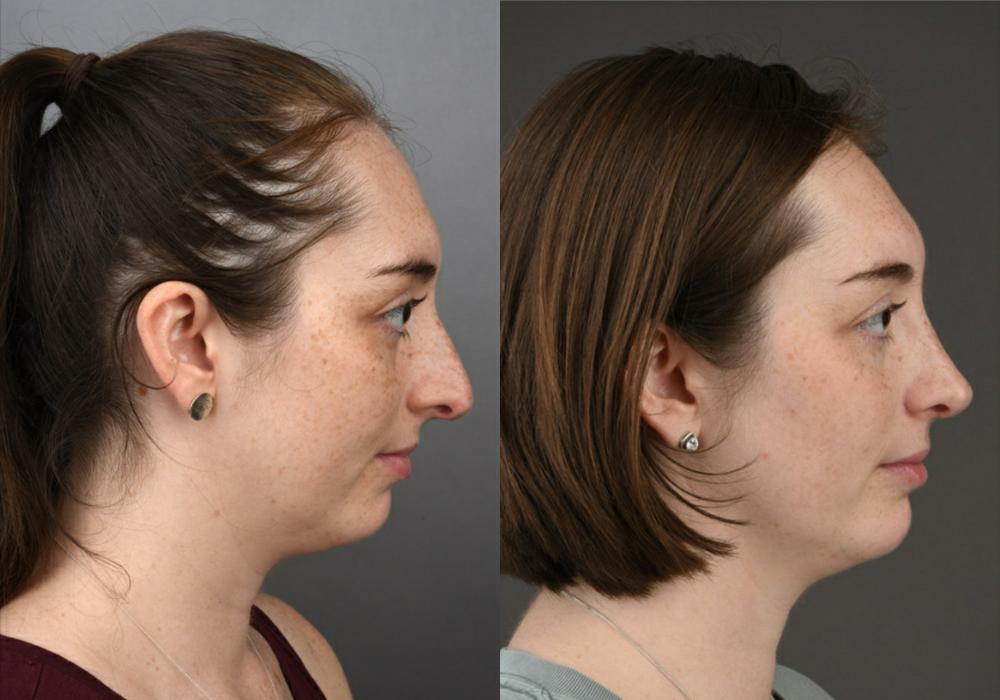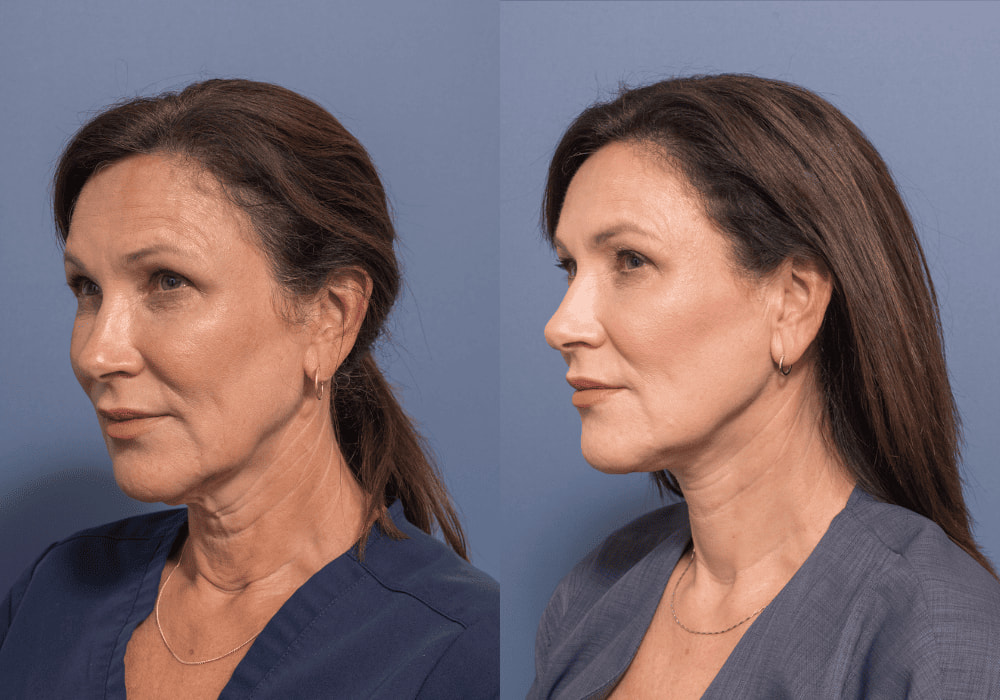
Lower blepharoplasty is a procedure that addresses aging changes in the lower eyelids, which can individuals appear older, sadder, and tired.
Lower Blepharoplasty: Address lower eyelid problems, including sagging, puffiness, and other age-related concerns
What is Lower Blepharoplasty?
As we age, the skin of the lower eyelids becomes loose, leading to wrinkles and crepey skin. Puffy lower eyelids from bulging fat pockets can cause bags under the eyes and loss of volume in the upper cheeks can cause dark circles to form. In addition, the outer corner of the eye, known as the lateral canthus, may droop, giving the eyes a rounded appearance. As each individual may have different concerns, Dr. Honeybrook tailors every lower blepharoplasty to meet each individual’s needs.
Aging of the Lower Eyelids
As we age, several changes occur in the lower eyelids, including:
- The eyelid skin becomes loose and may sag under the eyes
- Excess fat pockets can bulge and cause puffiness of the lower eyelids
- Volume loss in the upper cheeks can lead to the formation of dark circles under the eyes
- The outer corner of the eye, known as the lateral canthus, can droop and change the shape of the eyes from a youthful almond shape to an older round shape
How Lower Blepharoplasty Eyelid Surgery is Performed by Dr Honeybrook
Dr. Honeybrook performs lower blepharoplasty surgery using advanced surgical techniques that are tailored to the individual needs of each individual.
Transconjunctival Orbital Fat Compartment Excision/Repositioning: In this method, Dr. Honeybrook makes an incision inside the lower eyelid to remove or reposition excess fat deposits and improve the appearance of puffy lower eyelids. This technique leaves no visible scar on the outer surface of the eyelid.
Release of the Orbital Retaining Ligament: The orbital retaining ligament holds the lower eyelid in place. As we age, this ligament weakens, and the lower eyelid can droop or sag. Dr. Honeybrook releases this ligament to reposition the lower eyelid in an elevated position to restore a more youthful appearance.
Lower Eyelid Skin Pinch: This technique involves removing a small amount of skin from the lower eyelid to address lower eyelid wrinkles, and excess crepey skin. Dr. Honeybrook places the incision just below the eyelash line, so the scar is concealed and near invisible.
Canthopexy to Tighten the Orbicularis Muscle and Lateral Canthus: The orbicularis muscle is the circular muscle that surrounds the eye and the lateral canthus is a ligament that attaches the eye to the outer part of the orbital bone. As we age, the muscle and ligament can become lax, causing the lower eyelid to sag and the outer corner of the eyelid drops leading to rounder, beady appearing eyes. Dr. Honeybrook performs canthopexy in nearly all lower blepharoplasty cases to tighten the orbicularis muscle and the lateral canthus to tighten the lower eyelid as well as improve the shape and tilt of the eye.
Dr. Honeybrook combines these techniques to achieve natural-looking and long-lasting results for his individuals. After the procedure, individuals can expect a smoother, more refreshed appearance that can last for many years.
What Lower Blepharopalsty Surgery Aims to Achieve
- Corrects wrinkled eyelid skin
- Lightens dark circles under the eyes
- Decreases bulging fat pockets under the eyes
- Tightens the lower eyelid
- Improves the shape and tilt of the eye
- Corrects asymmetry of the lower eyelids
Who is a Good Candidate for Lower Eyelid Lift Surgery?
Lower blepharoplasty eyelid surgery may be a suitable option for men and women who have puffy bags, excess skin, wrinkles, dark circles and festoons under their eyes. Also, individuals with laxity of the lower eyelid, rounded, beady appearing eyes and drooping of the outer corner of the eyes may be good candidates for lower blepharoplasty. To determine whether you’re a suitable candidate for lower blepharoplasty it is best to make an appointment with Dr. Honeybrook.
Fat Transfer to the Lower Eyelids and Midface
In some instances, individuals may have a sunken appearance or tear trough deformity at the level of the lower orbital rim. Some may also have loss of upper cheek volume that can make them look older. That’s where autologous fat transfer can be complimentary to improve the appearance of the lower eyelid.
By combining fat grafting with lower blepharoplasty surgery, Dr. Honeybrook can revolumise the tear trough, orbital rim, and midface, and restoring a more youthful, rested appearance. The goal of lower eyelid surgery is to create a smooth, gently sloping convexity from the lower eyelid lash line to the most projecting point of the cheek. Autologous fat transfer involves harvesting fat from the individual’s own body, usually from the abdomen or thighs, and then injecting it into the target areas around the eyes.
One of the main benefits of using fat transfer in combination with lower blepharoplasty surgery is that it is a natural, long-lasting solution. Unlike synthetic fillers, which can require frequent touch-ups, autologous fat transfer uses the individual’s own tissue. Additionally, as the transferred fat cells are living tissue, they can continue to grow and adapt to the surrounding tissues, creating a more natural and harmonious look.
Another benefit of this combination procedure is that it can be customised to meet the unique needs and goals of each individual. Dr. Honeybrook will work closely with each individual to determine the ideal amount of fat to transfer, taking into account their facial structure, facial volume, skin tone, and desired outcome. By carefully planning and executing the procedure, he can achieve a result that looks natural, youthful, and balanced.
If you are considering rejuvenating your eyes, ask Dr. Honeybrook about the benefits of combining fat transfer with lower blepharoplasty surgery. With his expertise and experience, he can help you achieve a result that looks natural and enhances your unique features.
What is the Recovery After Lower Blepharoplasty Eyelid Surgery?
The early healing process can take approximately two weeks, and during this time, individuals may experience swelling and bruising.
It’s important to allow your body the necessary time to heal correctly, as this can impact the overall outcome of the procedure. Dr. Honeybrook will provide detailed post-operative care instructions, which may include limiting physical activity, avoiding certain foods or medications, and caring for the incisions.
After the healing process, individuals can expect to see a gradual improvement in the appearance of their lower eyelids within the first few weeks after the procedure. The area will look smoother and fuller, helping to restore a more youthful, rested appearance. The results of lower blepharoplasty surgery are long-lasting, making it an excellent investment in your appearance and overall self-confidence.
Note: Any surgical or invasive procedure carries risk. These risks will be discussed with you in detail during the consultation. For further information on risks please refer to the patient resources section of the website.





